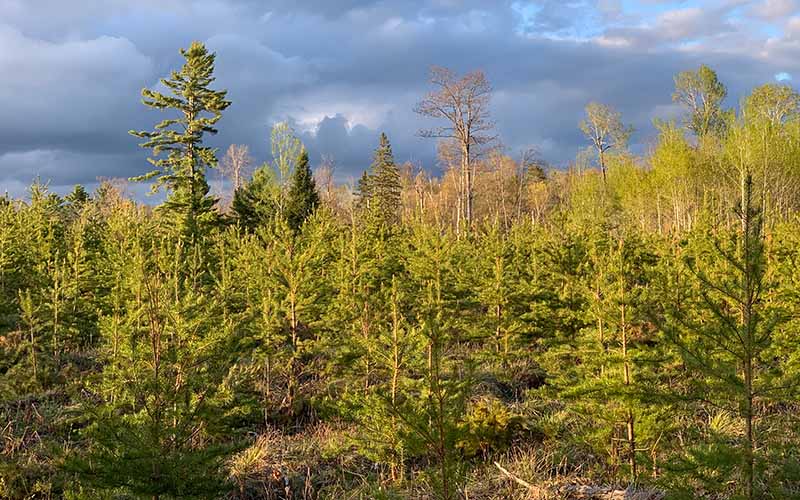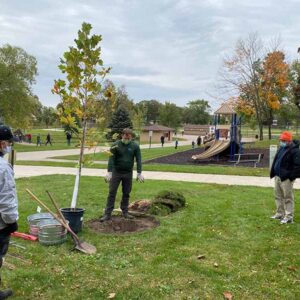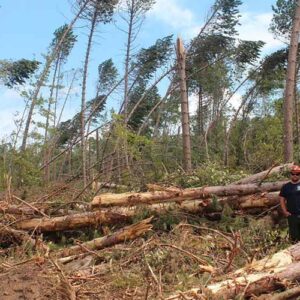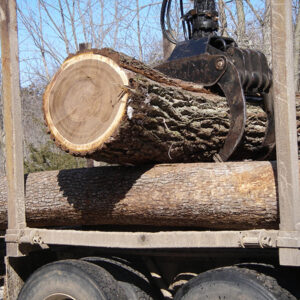Read this in Spanish / lee esto en español
A focus on climate impacts to Wisconsin’s forests in the most recent assessment from the Wisconsin Initiative on Climate Change Impacts (WICCI) shows that warming temperatures and changing precipitation patterns are impacting Wisconsin’s urban and rural forests. WICCI is a nationally recognized collaboration of scientists and stakeholders working together to help foster solutions to climate change in Wisconsin.
A group of experts participating in the WICCI Forestry Working Group found that warmer winters, extreme weather events, summer droughts, and longer growing seasons are impacting Wisconsin’s forests. Wisconsin’s average daily temperature has become three degrees Fahrenheit warmer and precipitation has increased 17 percent, about five inches, since 1950. The last two decades have been the warmest on record and last decade was the wettest. Winter has warmed about twice as fast as other seasons in Wisconsin over the past few decades.
Warmer winters
The group found that in northern Wisconsin, where most of Wisconsin’s forests are located, warmer winters are reducing the snowpack that insulates trees and other organisms, impacting forest operations such as harvesting and transportation that rely on frozen ground, and creating less lethal conditions for pests and diseases. These impacts can tip the competitive balance in forests from species like native boreal trees towards southern species. One surprising but substantial impact of warmer winters is the increase in deer herds. With less severe winters, especially in northern Wisconsin, larger numbers of deer are surviving and having a big impact on forest regeneration as they browse on understory plants, including sensitive species.
Extreme weather events
The group also found that extreme storms are happening more frequently and creating a great deal of damage in forests through flooding, erosion, and deposition of nutrients and invasive species seeds. These extreme storms also cause considerable damage to infrastructure on forest land, such as roads, trails, culverts, bridges, and campgrounds.

Summer droughts and longer growing seasons
In addition, the group found that warmer temperatures, longer growing seasons, and decreasing summer precipitation in northern Wisconsin, are increasing the risk for wildfires, pests, and disease. Reduced snowpack and earlier springs are also drying out vegetation at a faster rate in the spring and summer. While prescribed fires could help, it is becoming increasingly difficult to find a safe window to use them as the climate changes.
Impacts to culturally important species
Wisconsin tribes are working to help culturally significant species, like paper birch, adapt to changing conditions. With the guidance of tribal leaders, elders, and harvesters, the Great Lakes Indian Fish and Wildlife Commission has developed climate change vulnerability assessments to provide resources for tribes and their partners to respond to climate change and help maintain their treaty rights.
Impacts on communities
While all communities in Wisconsin are at risk, historically disadvantaged communities bear a disproportionate burden and suffer the greatest harms. For example, large canopy trees can play a big role in helping urban areas become more resilient to climate change, yet studies are showing a disparity in the location of tree canopy in some cities. In Milwaukee, for example, higher income neighborhoods have more trees than areas with renters and minority homeownership.
Solutions
The WICCI Forestry Working Group suggests solutions to prepare for and minimize the climate impacts to forests by keeping forests as forests, supporting holistic deer management, expanding forest cover in both urban and rural areas, and supporting climate-focused planning and management. Visit the Forestry Working Group webpage to learn more about these issues, impacts, and solutions.
This article is part of a series highlighting the contribution from each WICCI Working Group for the 2021 WICCI Assessment Report.
Support WICCI
Gifts to the Wisconsin Initiative on Climate Change Impacts (WICCI) Program Fund provide general, discretionary program support and are used to enhance and expand WICCI’s teaching, research, and public service roles. Gifts are also used to support partnership-building activities, include faculty, staff, and student recruitment, retention, and morale.
The Wisconsin Initiative on Climate Change Impacts (WICCI) is a statewide collaboration of scientists and stakeholders formed as a partnership between UW–Madison’s Nelson Institute for Environmental Studies and the Wisconsin Department of Natural Resources. WICCI’s goals are to evaluate climate change impacts on Wisconsin and foster solutions.


